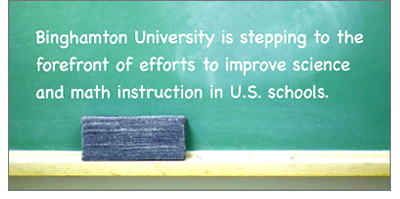page 1 | page 2
 Burch’s husband, Paul-William Burch, assistant research professor
of education, leads a CSMTE-affiliated project called Teacher Leader
Quality Partnership (TLQP). Beth Burch and Jean Schmittau, associate
professor of education, are co-principal investigators in the project.
Burch’s husband, Paul-William Burch, assistant research professor
of education, leads a CSMTE-affiliated project called Teacher Leader
Quality Partnership (TLQP). Beth Burch and Jean Schmittau, associate
professor of education, are co-principal investigators in the project.
Supported by a $1.1 million grant from the New York State Education Department, the four-year TLQP project is a partnership among Binghamton University, SUNY Albany, the Sage Colleges, Mount Saint Mary and The College of Saint Rose. So far, it has provided 165 middle-school math teachers and selected fourth- and fifth-grade teachers in small-city and rural districts in New York state with professional training sessions that focus on teaching math.
“In many cases, the grant is not only teaching methods for
how to teach it, but teaching the math itself,” deepening
teachers’ understanding of the concepts so they can better
convey them to students, Beth Burch said.
Schmittau, a specialist in math education, provides the math content
for teachers who attend the sessions at Binghamton University, including
teachers from the Binghamton City School District.
Meetings are marked by a great deal of lively discussion and collaboration, Paul-William Burch said. The program gives teachers “the opportunity not only to talk to each other about what has been successful” in the classroom, “but to engage speakers and university educators.”
TLQP trains participants to share what is learned in the seminars with colleagues in their schools. And since part of CMSTE’s mission is to focus on the needs of girls, students of color and students who are economically disadvantaged, TLQP offers “equity training” through the Albany-based New York State K-16 Alliance.
Other CSMTE programs in progress or recently completed include the $1.3 million Enhancing Education Through Technology program, which is funded by a grant from the New York State Education Department and provides computer equipment and training to teachers in the Binghamton City School District; a $150,000 Klee Foundation Award, which supports five science and five math education students in Binghamton’s master of arts in teaching program; and ecological investigations at the University’s Nature Preserve, which brought 480 Binghamton seventh-graders to campus for science field trips, using $6,200 from the Stephen David Ross University and Community Projects Fund.
While many colleges and universities operate teacher education programs, few of them “place as much emphasis on research-informed pedagogy at the program level,” O’Brien said. And while many programs use public schools as student teaching venues, they don’t necessarily offer much to those schools in return. Binghamton’s School of Education models a different approach and “has a long record of serving area schools,” he said.
Ron Fisher, assistant superintendent for secondary instruction and personnel at the Union-Endicott Central School District, agrees.
“They’re integral partners with us, in terms of providing professional development for our teachers, as well as providing opportunities for their students to work in the schools,” he said.
O’Brien feels confident CSMTE’s approach will add up to better math and science education. By working with public schools, promoting ongoing dialogues and training, better preparing new teachers and helping classroom teachers to employ research-informed teaching practices, the center seems to have devised a formula that promises to help spur a resurgence in U.S. math and science education.
page 1 | page 2